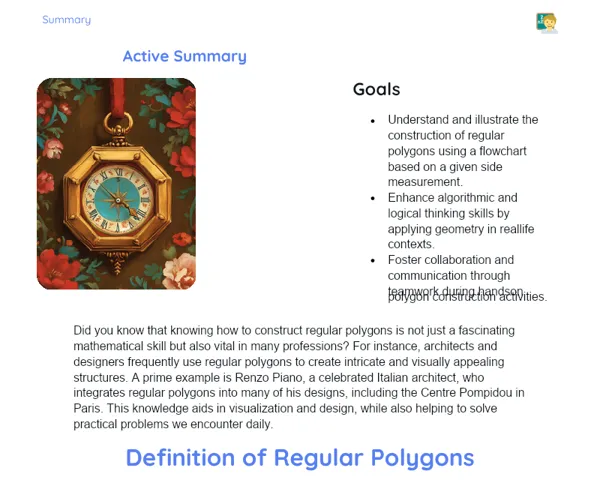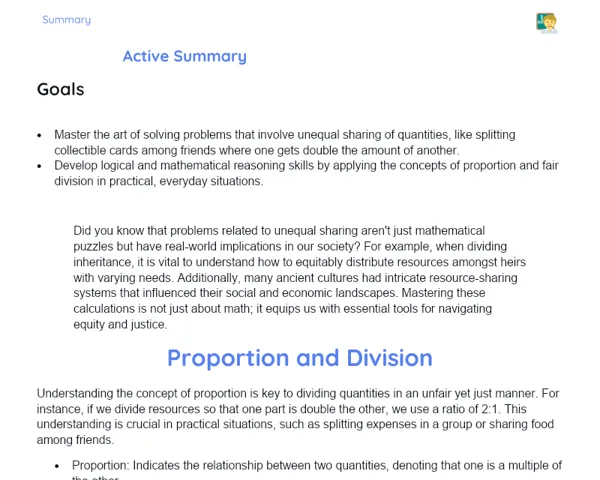Goals
1. Identify the main flat shapes, such as the square, circle, triangle, and rectangle.
2. Recognize the unique characteristics of flat shapes, including the number of sides and vertices.
Contextualization
Flat shapes are everywhere in our daily lives! From the floors we walk on to the toys our children play with, geometric shapes are the building blocks of our surroundings. Getting familiar with these shapes is critical right from a young age as it boosts our observation skills, logical thinking, and even sets the stage for future career paths. For instance, fields like architecture and engineering heavily rely on geometric shapes to draft blueprints for homes and buildings. Graphic designers make logos and layouts using these shapes, and in the fashion industry, designers use flat shapes to create beautiful fabric patterns.
Subject Relevance
To Remember!
Circle
A circle is a flat shape defined by all points that are equally distant from a central point. This constant distance is known as the radius. Circles have no sides or vertices.
-
Round shape with no angles.
-
Consistent distance from the center to any point on the circumference (radius).
-
Widely applicable in various fields, including design and engineering.
Square
A square is a flat shape characterized by four equal sides and four right angles (90 degrees). All four sides measure the same length, making it one of the most recognizable shapes in geometry.
-
Four equal sides.
-
Four right angles.
-
Commonly used in construction and interior design.
Triangle
A triangle is a flat shape that has three sides and three angles. Triangles can be classified into various types based on the lengths of their sides and their angles, such as equilateral, isosceles, and scalene triangles.
-
Three sides and three angles.
-
Different types: equilateral, isosceles, and scalene.
-
Essential in architectural designs.
Rectangle
A rectangle is a flat shape with four sides, where opposite sides are equal, and all angles are right (90 degrees). It is a very prevalent shape in construction and design.
-
Four sides, with opposite sides being equal.
-
Four right angles.
-
Frequently used in construction and graphic design.
Practical Applications
-
In architecture, an understanding of geometric shapes is vital for creating building plans and structures.
-
In graphic design, geometric shapes are fundamental for making logos, layouts, and other visual elements.
-
In civil engineering, comprehending geometric shapes is crucial for ensuring the stability and functionality of structures.
Key Terms
-
Circle: Flat shape made up of all points that are equally distant from a central point.
-
Square: Flat shape with four equal sides and four right angles.
-
Triangle: Flat shape that has three sides and three angles.
-
Rectangle: Flat shape with four sides, opposite sides equal, and four right angles.
-
Radius: The constant distance from the center of a circle to any point on its edge.
Questions for Reflections
-
How can an understanding of geometric shapes aid in future careers?
-
In what ways can you spot geometric shapes in your everyday life?
-
How can grasping the characteristics of flat shapes enhance your problem-solving skills?
Shape Hunt
Let’s put our learning into action with a fun activity! You will turn into a geometric detective, and your mission is to hunt for flat shapes around you.
Instructions
-
Take a piece of paper and a pencil.
-
Walk around your home or classroom, searching for items that showcase the flat shapes we've learnt: circle, square, triangle, and rectangle.
-
Sketch or jot down the objects you find and mark which geometric shapes they represent.
-
For each shape you discover, note how many sides and vertices it has.
-
Bring your list or drawings to the next class to share with your classmates.



